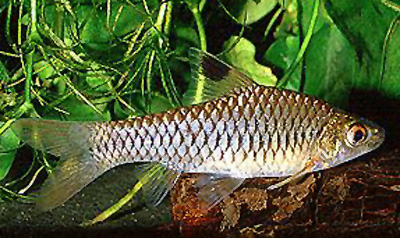| Cyprinidae (Minnows or carps), subfamily: Smiliogastrinae |
| 10.1 cm TL (male/unsexed); max.weight: 5.0 g |
|
benthopelagic; freshwater, |
| Africa: known from coastal basins in Benin to Cameroon, Chad basin and Benue River system (Ref. 2801, 2940, 81282), Bagoé (Niger basin) (Ref. 2940, 81282). Also present in Ghana (Ref. 272), Côte d'Ivoire (Ref. 272, 2940, 81282), Senegal (Ref. 2940, 81282), Cameroon (Ref. 81282, 81639) and Equatorial Guinea (Ref. 81639). Report from the Chiloango (Ref. 120641) probably refers to E. trispilomimus. |
|
Dorsal spines (total): 0-0; Dorsal soft rays (total): 11-11; Anal spines: 0-0; Anal soft rays: 8-8. Diagnosis: mouth subterminal; two pairs of short barbels; anterior pair not exceeding anterior margin of eye, posterior pair not reaching to anterior half of eye; lateral line complete and horizontal or slightly depressed below dorsal fin; scale formula 3.5/22-27/3.5; 2.5 scales between lateral line and pelvic-fin base; 12 scales around caudal peduncle; 8 branched dorsal fin rays; last simple dorsal-fin ray smooth on hind margin; no color pattern on sides; black spot on dorsal fin, but tip of fin colorless; maximum reported size 65 mm SL (Ref. 2940, 81282, 81639).
Description: medium-sized species; dorsal profile slightly convex; lines of cephalic pores well visible (Ref. 2940, 81282, 81639). D:III,8; A:III,5; dorsal fin with slightly concave border, last simple ray flexible, not serrated, nearly as long as head (Ref. 81639).
Coloration: ground color light, darker on back; lateral-line scales sometimes edged with black; in live specimens dorsal and caudal fins orange-red at base, other fins colorless; typical black spot on anterior dorsal-fin rays, above mid-height of fin, distal tip colorless (Ref. 2940, 81282, 81639). |
| Affinities: belongs to ablabes group, distinguished from other West African Barbus by the dorsal fin spot. B. deserti (spot fully covering dorsal tip) (Ref. 2940). Maximum SL observed is 65 mm (Ref. 2940, 81282). |
|
Least Concern (LC); Date assessed: 15 January 2020 Ref. (130435)
|
| harmless |
Source and more info: www.fishbase.org. For personal, classroom, and other internal use only. Not for publication.

